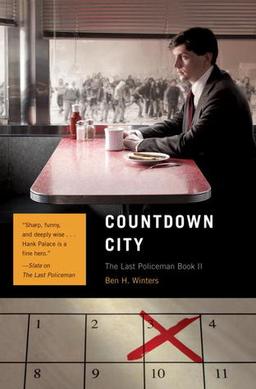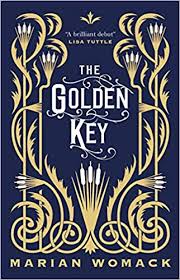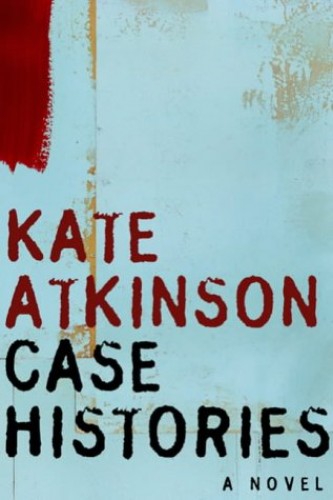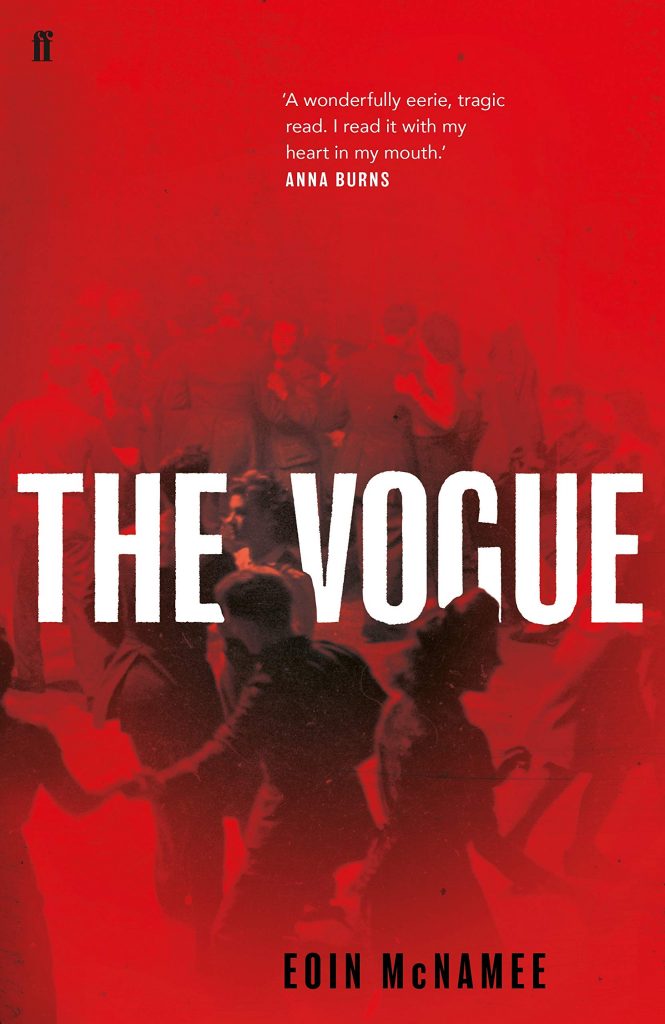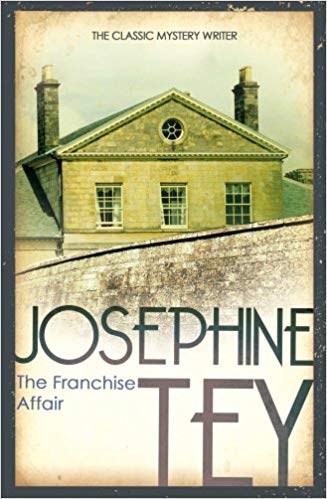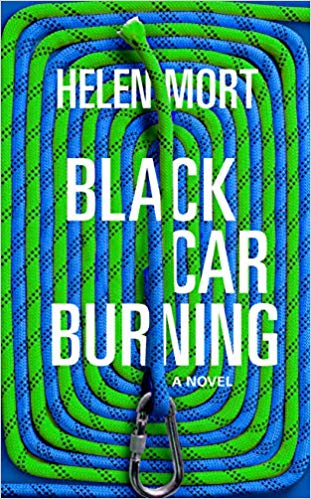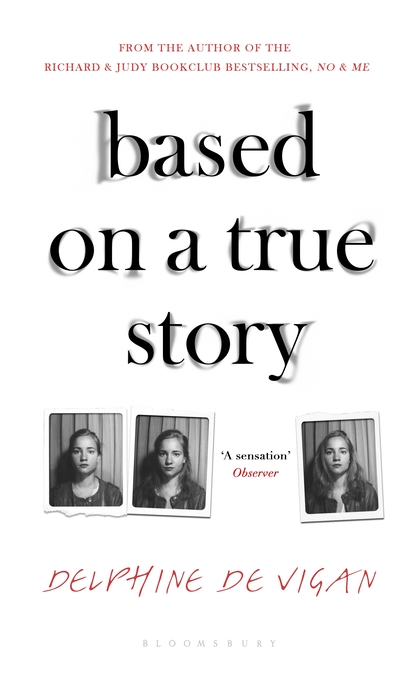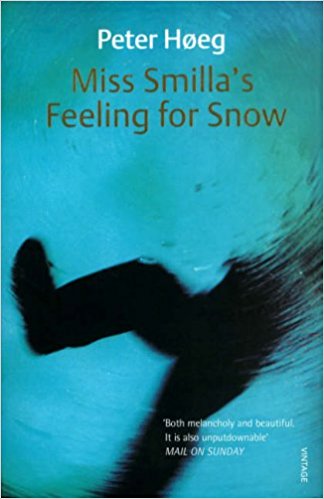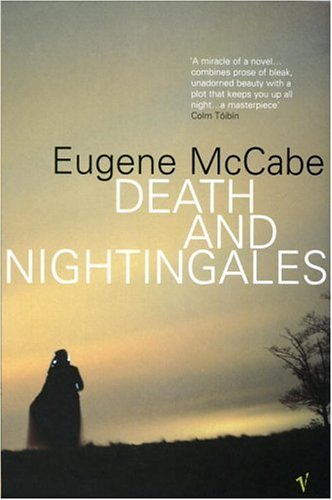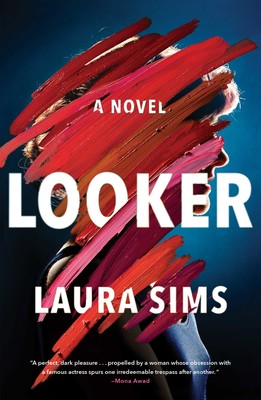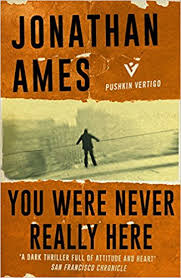In the first of two end-of-year posts I want to talk about my reading of crime fiction in 2018. Some of you may remember the Bute Noir crime reading challenge first thrown down by the organisers of Bute Noir way back in January. I thought this might be a useful and interesting framework for considering crime fiction and so it proved to be. While in one sense I failed the challenge – I did not manage to read a book in all thirty categories – I consider it a success in that it encouraged me to take in a broader spectrum of crime books than I might otherwise have encountered, all whilst reading a grand total of twenty-four titles overall.
BOOK WITH A ONE-WORD TITLE:
Sirens by Joseph
Knox
BOOK PUBLISHED IN 2018
The Fountain in the Forest by Tony White (January 2018)
I’ll Be Gone in the Dark by Michelle McNamara
BOOK WRITTEN BEFORE 1950
Double Indemnity by James M. Cain
BOOK BY A SCOTTISH AUTHOR
The Blackhouse by Peter May
BOOK SET IN SCOTLAND
Bloody January by Alan Parks
BOOK SET IN THE FUTURE
The Last Policeman by Ben H. Winters
BOOK WITH REAL-LIFE CRIMES
This House of Grief by Helen Garner
Joe Cinque’s Consolation by Helen Garner
Death of a Murderer by Rupert Thomson
BOOK IN TRANSLATION
The Pledge by Friedrich Dürrenmatt
BOOK SET IN AMERICA
So Much Pretty by Cara Hoffman
You Were Never Really Here by Jonathan Ames
BOOK SET IN NEITHER THE UK NOR THE US
The Shape of the Ruins by Juan Gabriel Vasquez
BOOK BY AN AUTHOR YOU HAVE NEVER READ BEFORE
Red Riding 1974 by David Peace
The Black Dahlia by James Ellroy
BOOK ADAPTED FOR THE SCREEN
On Beulah Height by Reginald Hill (ITV June 1999)
AUDIO BOOK
The Daughter of
Time by Josephine Tey (read by Paul Young)
BOOK RECOMMENDED BY A FRIEND
Jawbone Lake by Ray Robinson
BOOK WITH A TITLE OF MORE THAN SIX WORDS
I Hear the Sirens in the Street by Adrian McKinty
BOOK THAT YOU HAVE STARTED BEFORE AND NEVER FINISHED
Laidlaw by William McIlvaney
BOOK BY AN AUTHOR OF COLOUR
Bluebird, Bluebird by Attica Locke
BOOK BY A BUTE NOIR 2018 AUTHOR
The Cry by Helen Fitzgerald
So what did I discover? The short answer to that would be plenty, and that the loose and baggy genre of crime fiction is as riven with pleasures and problems as the loose and baggy genre of science fiction. Commercially I suspect they have a lot in common, these two estranged cousins: both are dominated, on the online airwaves, by an inner circle who go to all the conventions, who tend to ignore the work of so-called interlopers (to shun it if said interlopers get too mouthy) and who believe in their hearts and minds that it is they who are the guardians of the ‘real’ stuff, that they alone understand their chosen genre and know how to write it. This line of reasoning can get rather dull. In the world of the reader, who in most instances knows little of the internecine squabbling that so frequently dominates so-called genre spaces, the reality is much broader and much more open to enquiry. On hearing of my interest in writing crime fiction, a wonderful friend of mine once said to me: it’s really very simple – all you need is a crime or a criminal to write about. His words have stuck with me, not least because they might apply equally to science fiction – just find something weird and interesting and possibly to do with an imagined future you want to write about– and because they demonstrate above all the permeability of genre, the tenuousness of its existence. What we’re saying when we talk about ‘the genre’is simply that we like certain kinds of stories, stories that tend towards uncovering and solving a mystery, stories that tend towards looking at the world in a way that would seem to expand the nature of what we call reality. Sometimes they do both. What is certain is that there are no rules as to who is allowed to tell these stories, and that those hierarchies that exist within so-called ‘genre circles’ are seldom if ever a reliable yardstick for finding their most challenging and memorable examples.
Far and away the best ‘troubled cop’ story I’ve read in along time and this year certainly was William McIlvaney’s magisterial Laidlaw. I am far from the first to express similar sentiments, and very late in discovering McIlvaney’s genius for myself, but what is it about his approach to the simple police procedural that raises it so high? There’s the writing, for a start. McIlvaney writes Glasgow –its speech and its rhythms – in an unadorned, unselfconscious manner that is a constant delight and matter for admiration. But he’s never afraid to express abstract ideas or to reach for the language that best expresses them. This kind of confidence to mix philosophy with street talk is rarely encountered and even more rarely successfully executed. In McIlvaney it comes across as easy assurance but what it is, of course, is the considered hard graft of the committed artist. Then there’s the story. No ludicrous plot twists or high octane car chases for our Willie and what a blessed, blessed relief that turns out to be. In Laidlaw we get a murder that like the vast majority of real murders is senseless, squalid, awful,should never have happened and that ripples out into the community with knock-on effects that are devastating, sad and unexpected. The whole ensemble resists sensation, and sensationalism. People travel around by bus. The understatement of the ending is possibly the most truthful and affecting I’ve ever read in a crime novel. The social attitudes are showing their age a little now but no matter, the underlying fabric and pure intent of this novel is so solid, so skilfully worked it will never age.
Of course a writer as skilful and groundbreaking as McIlvaney will have his imitators – who wouldn’t want to be that brilliant? But for every book as remarkable as Denise Mina’s The Long Drop there are a dozen instantly forgettable generic procedurals that serve only to reinforce the uniqueness of their inspiration, Alan Parks’s Bloody January being an interesting case in point. Allan Massie’s typically insightful review in The Scotsman lays out the case beautifully, and while it is clear from the overall soundness of the structure and attention to place that Parks cares very much about what he is doing, you can’t get away from the fact the results are merely adequate rather than special. Parks’s anti-hero McCoy is just your standard troubled cop, the Dunlops are cardboard villains and the victims are simply placeholders. The ambiguities and complexities that are the lifeblood of Laidlaw are all but absent.
Swapping Glasgow for Manchester, Joseph Knox’s debut Sirens suffers from similar problems. This debut novel arrived garlanded with praise and I was expecting something special, yet it disappointed me in similar ways to Stav Sherez’s The Intrusions from 2017. Both have wanker protagonists and not in a good way (are we meant to feel sympathy for poor, beleaguered, addicted, semi-disgraced Aidan Watts? Short answer, I didn’t), both are novels awash with predictably sexist attitudes hidden beneath the guise of ‘look at me, I’m exposing sexism’, both attempt to cover middling to poor character work with convoluted and ultimately tedious plots. In both cases, the writing is fine – always serviceable, occasionally even interesting, but any effort here is ultimately futile because the overall concept is just so tired.
Across the water in Northern Ireland, Adrian McKinty’s I Hear the Sirens in the Street could have been just as uninspiring but somehow it saved itself. In so many ways it’s a bad book – unconvincing third-act denouement, bolt-on musical references (some of which are anachronisms – see the reference to an Arvo Pärt record in 1984, also the idea that someone might not have heard of Blondie by the same year) and above all appalling gender politics – the scene where Duffy seduces Gloria is the worst-written in the entire novel – which, again, do not come across as ‘gritty analysis of how sexist things were in the 1970s’ so much as just… sexist. However, there’s something about this author’s voice that made the novel extremely, likeably readable. Duffy’s a bit of a dick but I still got on with him. The police work– when we’re not in that final shoot-out – is interesting and makes for a good detective story. The sense of place is excellent in spite of too much clunky political exposition. While I Hear the Sirens in the Street cannot compete with the sheer writerly excellence of a novel like Laidlaw, I were in the mood for an ultimately pointless but pleasurable procedural I could well find myself choosing another in this series. McKinty has flair. And some of his jokes were actually funny, so kudos for that.
Moving from the gritty, city police procedural to the provincial detective story, I found interesting comparisons to be made between Peter May’s The Blackhouse, set mostly on the Isleof Lewis, and Reginald Hill’s On Beulah Height, set in Yorkshire. I found On Beulah Height to be a very good police procedural. Intelligent,forensically detailed, great sense of place and an entirely convincing portrayal of small-town life – it’s immediately clear why Reginald Hill garnered so many fans. There’s nothing groundbreaking here, at all – but with this kind of attention to detail and overall respect for craft, a book like this can be amply enjoyed for what it is, which is a good story, well told. My expectations for May’s The Blackhouse were similarly high. Unfortunately they weren’t met. While the writing about the island and its traditions is good, solid stuff, the plot is a great lolloping mess of a shaggy dog story. Murder, bullying, paedophilia, repressed memory,death of parents in a car crash, death of aunt from cancer, death by plummeting from a rock (father and son), fake rape confession – is there anything that isn’t in this book?? It’s all very pat, very generic, and that’s without the rampant,unconscious sexism on the part of the author – the objectification of women is constant and boringly consistent, and guess what? Not one woman has a real role or genuine agency – such dullness should be outlawed. Far more of a problem in police procedural terms is that The Blackhouse simply doesn’t deliver: there is way too much soul-searching-via-flashback (the whole novel is ultimately one giant flashback) while the murder itself turns out to be mostly irrelevant. (The original murder in Edinburgh that kickstarts the whole business is indeed never mentioned again!) I think it’s fair to say that I was disappointed.
Far more interesting to consider are the two novels I read in the ‘author I’ve not tried before’ category. Both giants of crime writing, I had hitherto read a great deal about David Peace and James Ellroy without actually having sampled a novel from either one of them. It was time to break that duck. In both cases I’m glad I did, though for differing reasons. I consider the Channel Four adaptations of Peace’s Red Riding novels to be masterpieces of the small screen, some of the best British TV since Peter Flannery’s Our Friends in the North. There’s an interview with Peace that I’ve read multiple times, in which he states the importance of creating crime fiction that stems from lived reality. For me, pretty much everything Peace says about writing and crime fiction in particular is inspirational and thought provoking in the most constructive way possible –which is why I felt surprised and not a little cheated to find him breaking some of his own rules. The background to Red Riding 1974, the sense of place and time is, as we might expect, impeccably drawn, yet the violence and torture involved in the crimes at the heart of the novel are gratuitous and have little to do with the times, incorporating precisely the kind of serial-killer-thriller tropes so rightly decried by Peace in his interview. His portrayal of women is just a joke, with ‘our hero’ Eddie no hero whatsoever in this respect. Also how come Eddie himself is so ready with his fists? He’s meant to be a journalist. We learn next to nothing about him, about his motivations, and his readiness to resort to insane levels of violence and misogyny undermines any belief we may have in his fight for justice. It’s hard to escape the impression that this is yet another novel about men using their supposed (and mostly unconvincing) rage at the death of female children as an excuse to get into it with each other, which makes me sad, because Peace’s writing is compelling and plays merry havoc with the established formulae of the police procedural.
All that being said, I will return to Peace and I will complete my reading of the Red Riding Quartet, because the sense of place, the texture of his reality is Gordon-Burn-good. In addition to that, there is the sense with Peace that he is self aware about his blind spots, that he is constantly pushing himself towards new levels of insight. Which is more than I can say for James Ellroy and The Black Dahlia. Ellroy is famous as a monster of ego, which for me makes that ego itself a trope and therefore dull.So he owns thirty guns and thinks he’s the Beethoven of crime fiction, so what? Ellroy’s writing is as tight as a drum and on that level he really is the natural heir to Chandler. But his attitudes – which I’m guessing are meant to shock us with their retrograde offensiveness, a constant tirade of ‘this is how it was, guys, so suck it up’ – are so unexamined and so much a barrel of cliché– mean streets, tough cops taking it to the lowlifes and paedos and (mostlyMexican) scum, trouble at t’ LAPD mill where it’s hard to tell the heroes from the villains in a world where women, unless they’re madonnas, whores, or murdered bodies don’t exist at all – that reading this book becomes almost laughably tedious. To paraphrase another stroppy American, he cannot be serious. The scene where one of our heroes is driven to psychotic levels of outrage by… the existence of lesbian sex had me totally bemused. To use a well worn phrase, it’s like watching a child throw its toys out of the pram. I’m kind of interested to read one of his more recent novels, just to see if Ellroy has grown up at all, but it might be a while. I cannot stress how much betterJonathan Ames handles a similar milieu and street scene in You Were Never Really Here, and if you are interested in how to write effectively and with genuine impact about violence against women then Cara Hoffman’s So Much Pretty is excoriating,brutal, brilliant, as well as being one of the most accomplished crime novels I’ve yet read. If it’s noir you’re after, you could do a lot worse than return to the heartland. James M. Cain’s Double Indemnity is a beautifully crafted mystery with a satisfying simplicity and economy of style that many more modern practitioners would benefit from taking note of. You could read this in almost the same time it takes to watch the movie and enjoy it just as much.
Myencounter with Josephine Tey, in the audio book category, was interesting. Teyis often portrayed as the overlooked outsider, a master of Golden Age crimefiction whose visibility has been overshadowed by the perennial popularity ofAgatha Christie. It just so happened that Radio 4 Extra were rerunning PaulYoung’s unabridged serialised reading of Tey’s The Daughter of Time earlier in the year, which made for a perfectopportunity to discover this important and underappreciated writer for myself. The Daughter of Time features Tey’sregular detective, Alan Grant, as he researches a cold case while laid up inhospital after an accident with a burglar. The cold case in question is themurder of the two Princes in the Tower, supposedly ordered by their uncle, thefamously dastardly bastard Richard III. But is the case as open and shut as thehistory books would have us believe? This novel is at its heart an explorationof the way in which history is created after the fact, and I have to say Iloved Tey’s investigative approach, her use of detective fiction to tackle animportant subject, her obvious passion for the misrepresented ‘hero’ at theheart of her novel. I actually preferred this treatment – that energising linkbetween past and present – to Hilary Mantel’s brand of needlepoint reimaginingin Bring Up the Bodies, which I alsofinally got around to reading this year and found rather static. Tey is sharp,acerbic, funny. If it weren’t for the painful layers of internalised misogyny, The Daughter of Time would be theperfect bedtime detective read.
Another
unexpectedly perfect procedural was Ben Winters’s The Last Policeman. An investigation that takes place against the
background of Armageddon-by-meteor, this turned out to be a really excellently
put-together book that works equally well as a police procedural and a work of
science fiction. The claustrophobic atmosphere is striking, the
characterisation of our protagonist, obsessive cop Henry is great. As science
fiction, The Last Policeman impresses
precisely because the SF is approached from a sideways angle. A sad, affecting
novel that speaks to our times. I’ll definitely be coming back for the sequels.
More disappointing to me was Attica Locke’s Southern procedural Bluebird, Bluebird. I’ve heard such
great things about Locke’s novels and many of them are true. As an examination
of race issues in the South and the trauma and inequality and personal danger
involved in being a Black cop not just within a racist society but within a persistently
racist law enforcement apparatus, Locke’s voice is essential and important. But
although the characters are solidly crafted – what a welcome change it makes to
read about a policeman who goes against the ‘troubled cop’ stereotype – in
essence, Bluebird, Bluebird is just a
standard whodunit. From the ecstatic reviews I’d read of Locke’s work I’d
imagined something deeper and more game-changing, more interestingly written.
I have to say that Ray Robinson’s Jawbone Lake disappointed me a little, also. Robinson’s feeling for the Peak District is intense and real and he does not shrink from revealing the stark divisions within the community. For those who live on the Nether Tor Estate and work in the local ice cream factory, the climate is harsh and unforgiving and it is only those with means and leisure who are able to rejoice in the landscape as it appears in hotel brochures. Rabbit especially is an interesting character – her talent for mathematics, the way we see her gradually begin to heal after the death of baby Jasper – but the great hole at the centre of this book is the wealthy Arms family. Joe is a blank slate and a real pain, we barely get to know Eileen, Bill is well drawn but there are leaps in logic. CJ’s crimes themselves are boringly predictable and we never really get an ‘in’ as to why he went down that road or what he was like. There is some excellent writing about Joe in Hastings but the eventual denouement is too simplistic –Joe’s money solves everything, which feels like a cop-out. Also, the gun battle in the hotel room is just plain stupid. I kept wondering, above all, what inspired Robinson to write this novel because ultimately it felt like a hollow book and I much preferred his earlier mystery, Forgetting Zoe.
The Cry by Helen Fitzgerald is a great deal better as a novel than in its recent BBC screen adaptation. The TV series works by withholding crucial information for almost half its length. I’m not a fan of withholding as a narrative technique and it is to Fitzgerald’s credit that her original novel does not make use of it. As readers, we learn the brutal facts of this case within the first fifty pages. The suspense is generated – as it should be – through character and relationships: what will happen to whom when the truth becomes known. There’s nothing flashy or particularly evocative about Fitzgerald’s writing but she knows how to get inside the skin of a person and the situation in which she places her characters makes for compulsive reading. If it weren’t for the stupid ending – the too-convenient dispatch of the most odious character (not that they don’t deserve it, it’s just a cheap move) – The Cry would score highly with me as an original and thought-provoking thriller.
Some of the my absorbing and satisfying reading this year has come in the form of true crime – indeed I am constantly on the lookout for new or previously overlooked works at the high end of this category. Anyone interested in crime writing should be reading Helen Garner. I read This House of Grief and JoeCinque’s Consolation in close succession and found them dauntingly good, onso many levels– clarity of vision, self-analysis, factual detail, sentence structure, social comment, characterisation, the showing, the telling, sheer writerly beauty. I’m intending to read everything Garner has written. One’s heart breaks for Michelle McNamara, who devoted more than a decade to what can only be called a private detective’s quest to discover and unmask the true identity of the Golden State Killer. McNamara died before she was able to complete her book detailing these investigations, and less than three years before the killer was finally arrested. The book – I’ll Be Gone in the Dark – was posthumously completed by crime writer Paul Haynes, a journalist, Billy Jensen, and McNamara’s husband Patton Oswalt. We can feel grateful for their dedication and close attention and respect for what McNamara wanted and as a unique entry in the annals of true crime, I’ll Be Gone in the Dark is indispensable. We cannot ignore the fact though that McNamara’s tragically untimely death means the book is flawed. It is only really the sections McNamara completed that glow with intent and commitment, that feel fully realised. The rest read like bridging material, which of course and through no fault of anyone’s is exactly what they are.
The most satisfying books in crime as in any area of literature tend to be those that do not fit easily into any category, that confound expectations. Tony White’s The Fountain in the Forest contains some of the best police procedural writing I have encountered – gritty, dense with detail, obsessively forensic – and on the level of a detective story it is entirely satisfying. That it also works as an experimental novel of the OULIPO school, and as a work of political and social commentary gives it a denseness and what I can only call composure that few novels in any genre can hope to emulate. Juan Gabriel Vasquez’s The Shape of the Ruins is the very best kind of autofiction – the kind that is actually about something. It is also an important account and interpretation of historical events, an investigation of conspiracy and obsession, an immensely satisfying chunk of effortlessly beautiful writing (brought to non-Spanish speakers in Anne Maclean’s effortlessly beautiful and idiomatic translation) and – of course – a dark and disturbing murder mystery. Vasquez is one of the most interesting and important writers working. The narrator of Friedrich Dürrenmatt’s The Pledge would have us believe that all detective fiction is a waste of time – before plunging us into a detective story we cannot help but consume in a single sitting. The Pledge is part of Pushkin Press’s Vertigo imprint, devoted entirely to crime fiction in translation, a goldmine of fascinating titles, many of them available in English for the first time. Leaving the best till last, Rupert Thomson’s Death of a Murderer might almost be described as an anti-crime novel. The action, if it can be called that, takes place over a single night,as a police officer is sent to guard the body of an unnamed murderer (it’s Myra Hindley) on the eve of her funeral. As he looks back to the time of the original crimes, strange truths and darker memories begin to be revealed. Thomson explores the lives most of us lead – ordinary tragedies illuminated by moments of danger and hubris and daring. Beautifully judged, humane, dignified,unusual, subtle, sad and uplifting, Death of a Murderer is quite simply a stunning book, perfectly understated and immaculately told. It also shines a necessary light on our love for detective fiction, on our own motives and ambitions for reading and for writing it.
Well, that was my year in crime fiction, a journey that has been informative, inspiring, compelling, sometimes frustrating, occasionally ludicrous, always fascinating. A journey I am intending to continue in 2019 as I seek out ever more challenging and weird examples of detective fiction as well as revisiting some old favourites. In the meantime, I aim to return here later this month for Part 2 of my End of the Year reading summary, in which I’ll talk about books that aren’t about murder, or at least not specifically, aswell as reading and writing plans for the year ahead.
